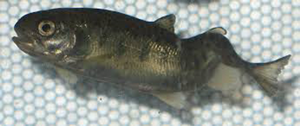Whirling Disease
In the years that rainbow trout have repopulated the Madison River since the whirling disease die-off in the mid-1990s, Dick Vincent has noticed something very curious and troubling. Few of the Madison’s rainbows survive into their third year, and growth rates are down about 30 percent.
A decade ago Montana’s famous trout fishery became the poster child for the epidemic, caused by a non-native parasite, looming over one of the West’s most cherished natural resources. These days, trout are back in the Madison—although only at half their pre-epidemic numbers of 3,500 catchable trout per mile--and the storied blue-ribbon stream has resumed its place as Montana’s most heavily fished waterway.
Although the disease-causing parasite, Myxobolus cerebralis, still permeates the Madison, the river’s rainbow show markedly lower rates of infection than in the 1990s, back when some were predicting doom. The best explanation for this development is that new generations of rainbow trout have inherited genetic resistance to the disease that degrades the cartilage in the spines of young fish. This may not be something to celebrate, says Vincent, a veteran fisheries biologist who came out of retirement to coordinate Montana’s response to whirling disease.
“We need to find out what the heck is going on in the Madison,” says David Kumlein, a former Madison guide who is now executive director of the Whirling Disease Foundation in Bozeman. “Maybe we’ll have resistant fish, but will it be useful for sustaining a sport fishery?. Are we going to settle for six-inch fish?”
Vincent suspects Madison trout populations lost crucial genetic diversity in the whirling disease die-offs of the 1990s, which could have dire consequences down the road. State fisheries scientists, meanwhile, are divided over the significance of Vincent’s data. Regional fisheries chief Bruce Rich disputes Vincent’s suspicions, and took steps to keep them out of a recent edition of Montana Outdoors, FWP’s magazine.
Here’s the soundbite version of Vincent’s findings.
In a 1999 experiment on Madison trout, all the fish tested showed severe levels of infection after controlled exposures to the parasite that causes whirling. When the experiment was repeated five years later, however, less than half the fish showed severe infection, while 30 percent had little to none.
“The [initial outbreak] probably killed all but .5 percent of young fish between 1991 and 1997,” Vincent says. “Those few that survived had genetic resistance and entered the spawning population by 1998. We think significant selection occurred. It was a horrific bottleneck. Some good genetics may have been lost in getting the resistance. The fish showing resistance are showing poor survival as adult fish, two or three years old.”
If these fish don’t reach spawning age (generally four years for male, five for females), the fishery may collapse again.
“Over the period of his career, Dick has been right about a lot of things,” says FWP fisheries chief Chris Hunter. It was, after all, under Vincent’s guidance 30 years ago that Montana adopted a then-maverick policy of managing trout fisheries to favor wild, as opposed to hatchery-raised, fish.
But Vincent’s views on the state of the Madison fishery remain “a theory, a hypothesis with little information to back it up at this point. We won’t have an answer for a few more years,” Hunter cautions.













